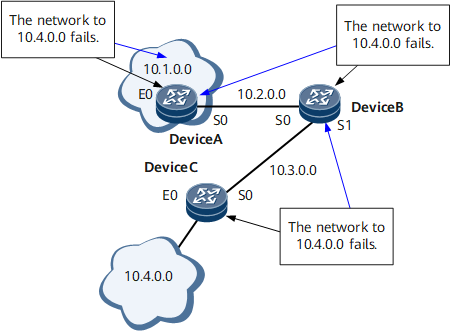Triggered Update
The principle of triggered update is that when the routing information changes, it immediately sends a triggered update message to its neighbor to notify the changed routing information.
Triggered update allows a device to advertise routing information changes immediately, which speeds up network convergence.
In Figure 1, if the route to 10.4.0.0 becomes unreachable, Device C learns the information first. By default, a RIP-enabled device sends routing updates to its neighbors every 30s. If Device C receives an Update packet from Device B within 30s while Device C is still waiting to send Update packets, Device C learns the incorrect route to 10.4.0.0. In this case, the next hops of the routes from Device B or Device C to network 10.4.0.0 are Device C and Device B respectively, which results in routing loops. If Device C sends an Update packet to Device B immediately after it detects a network, Device B can rapidly update its routing table, which prevents routing loops.
In addition, if the next hop of a route becomes unavailable due to a link failure, the local Device sets the cost of the route to 16 and then advertises the route immediately to its neighbors. This process is called route poisoning.
